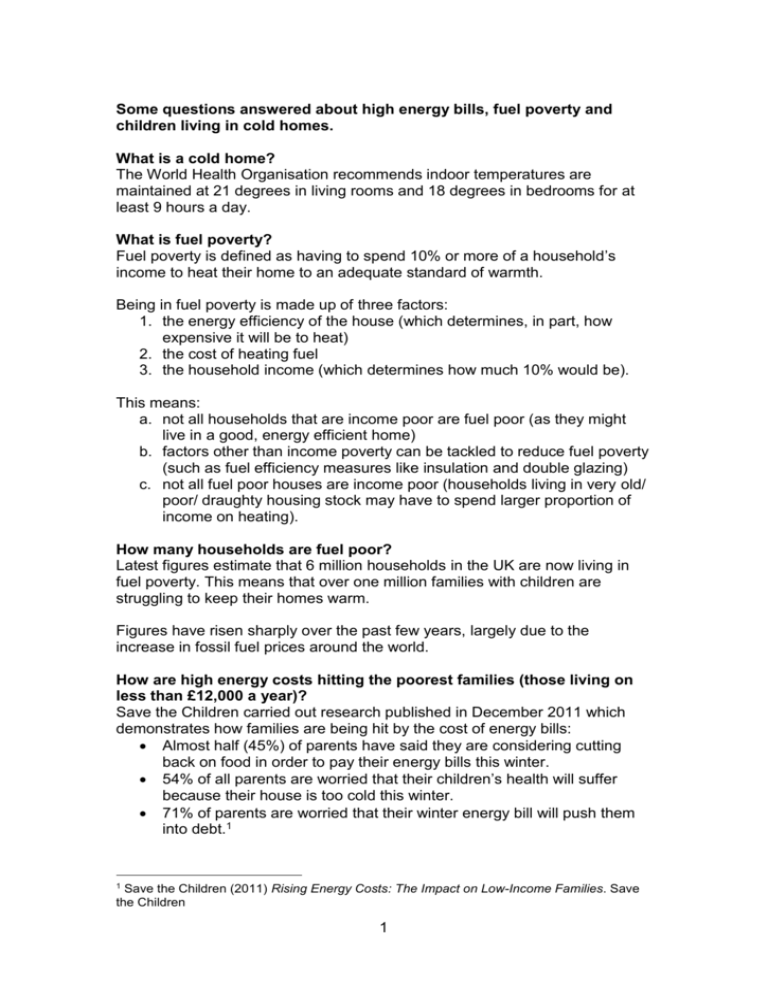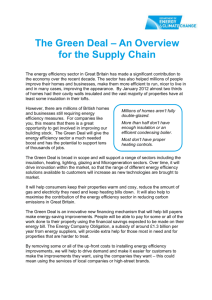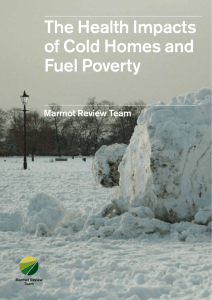Energy efficiency = reducing fuel poverty = improving health
advertisement

Some questions answered about high energy bills, fuel poverty and children living in cold homes. What is a cold home? The World Health Organisation recommends indoor temperatures are maintained at 21 degrees in living rooms and 18 degrees in bedrooms for at least 9 hours a day. What is fuel poverty? Fuel poverty is defined as having to spend 10% or more of a household’s income to heat their home to an adequate standard of warmth. Being in fuel poverty is made up of three factors: 1. the energy efficiency of the house (which determines, in part, how expensive it will be to heat) 2. the cost of heating fuel 3. the household income (which determines how much 10% would be). This means: a. not all households that are income poor are fuel poor (as they might live in a good, energy efficient home) b. factors other than income poverty can be tackled to reduce fuel poverty (such as fuel efficiency measures like insulation and double glazing) c. not all fuel poor houses are income poor (households living in very old/ poor/ draughty housing stock may have to spend larger proportion of income on heating). How many households are fuel poor? Latest figures estimate that 6 million households in the UK are now living in fuel poverty. This means that over one million families with children are struggling to keep their homes warm. Figures have risen sharply over the past few years, largely due to the increase in fossil fuel prices around the world. How are high energy costs hitting the poorest families (those living on less than £12,000 a year)? Save the Children carried out research published in December 2011 which demonstrates how families are being hit by the cost of energy bills: Almost half (45%) of parents have said they are considering cutting back on food in order to pay their energy bills this winter. 54% of all parents are worried that their children’s health will suffer because their house is too cold this winter. 71% of parents are worried that their winter energy bill will push them into debt.1 1 Save the Children (2011) Rising Energy Costs: The Impact on Low-Income Families. Save the Children 1 How much do people pay for their energy? The average dual fuel bill (for both gas and electricity from the same provider) is now £1,345 per year. Many consumers – in particular poorer consumers without bank accounts to pay by direct debit or with pre-payment meters due to arrears – are not eligible for the cheapest deals and so pay higher rates for their fuel. How is children’s health affected by cold homes? Children’s health and well-being can be badly affected by living in inadequately heated housing: They are more than twice as likely to suffer from a variety of respiratory problems, such as asthma and bronchitis, as children living in warm homes. More than one in four adolescents living in cold housing are at risk of multiple mental health problems – the figure is one in 20 of those who have always lived in warm housing. Cold housing also negatively affects how children perform at school and their emotional well-being. Many of the most vulnerable members of society, including disabled children, spend longer in the home than most, and require the heating on all day. According to a survey from Contact a Family, two thirds of families with disabled children struggle to pay their energy bills in the winter time. How can people living in fuel poverty be helped? The easiest one of the three factors making up fuel poverty to change is energy efficiency. Making homes more energy efficient is a long-term, sustainable solution, which will allow people to use less energy to heat their homes adequately. This will have a positive impact on carbon emissions and on fuel bills. What is a fuel efficient home? Some people call fixing houses so that energy is not wasted, ‘fuel poverty proofing’. This means that the house is so energy efficient that people do not need to spend a lot of their income to keep warm. If you think of the stickers that you might have seen on the side of washing machines and light bulbs, this will help you that about what is fuel efficient. 2 If all properties in England were in band B, it would raise 83% of households out of fuel poverty2. Half of the existing housing stock in our country falls well below this standard and most homes built before the 1920s fall within bands F and G. Current building regulations require a SAP rating between 65-81 (top of band D and above) for newly built houses. How can energy efficient homes help the Government? Energy efficient homes will reduce carbon emissions from our houses, helping the environment and helping the UK meet its target of cutting CO 2 emissions by 34% of 1990 levels by 2020. They will also help the government to meet its legal duty to eliminate fuel poverty by 2016. How much does it cost to make a home fuel efficient? The vast majority (84%) of the UK’s least energy efficient homes could be brought up to near-average standards for less than £3,000. (This would bring them up to band E. The average for homes in UK is now band D). Here are some of the measures that can be taken to improve energy efficiency: Measure Typical cost Typical payback period Loft insulation £250 Up to two years Draught proofing £200 Four to eight years Cavity wall insulation £250 Two years Solid wall insulation £1,500 - 10,000 Five to 20 years Boiler replacement £500 – 1,000 Two to five years Double glazing £0 – 4,000 Five to ten years A small proportion of properties will be hard to make decent and will cost over £5,000 to improve. 2 Guertler P and Preston I (2009) Raising the SAP: Tackling fuel poverty by investing in energy efficiency. Consumer Focus 3 Some of these measures can be taken by individuals and some need professional contractors to undertake. Why should we make our homes energy efficient? As well as cutting energy bills, making homes energy efficient ensures we are not wasting energy and contributing to climate change. Domestic energy use is responsible for around a quarter of the UK’s CO2 emissions (over 70% through space and water heating). Poor insulation means around £1 in every £4 currently spent heating homes is wasted. How do people pay for these improvements? Currently people can pay for these energy efficiency measures themselves if they can afford it. There are also taxpayer funded schemes to install energy efficiency measures in homes occupied by low-income or vulnerable households, such as Warm Front. In addition, energy companies have schemes to support improvements in some households. From autumn 2012, there will be a new scheme available called the Green Deal. This is not a taxpayer funded scheme but allows private energy companies to provide financing for customers (both domestic and commercial) to make energy efficiency improvements and reduce heating bills. The Energy Company Obligation (ECO) will support those householders (on lower incomes or with properties that are more difficult and expensive to improve) that do not qualify for the Green Deal. Cutting carbon emissions Boosting energy efficiency Improving children’s health and well-being Reducing fuel poverty 4









